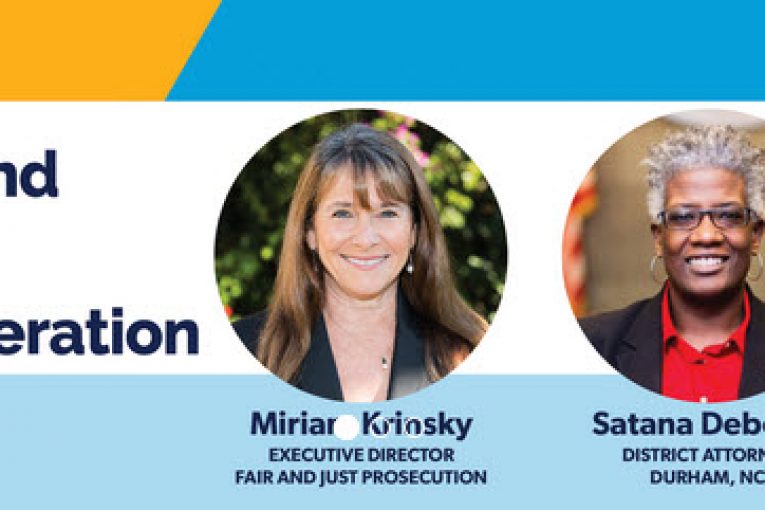

On Friday, the Pretrial Justice Institute Hosted a discussion on the role of the prosecutor and sheriff in COVID-19 decarceration.
Miriam Krinsky from Fair and Just Prosecution called COVID-19 “a ticking time bomb” which she said “is spreading through those facilities which are overcrowded and too often unclean.”
She noted that in 2017, 35 states operated at at least 85 percent of their capacity and in 10 of them, they are operating at or above full capacity.
Krinsky argued, “Even if it were possible to become more hygienic, it’s practically impossible for people to socially distance and to ensure that medical treatment is up at a standard that we should all be demanding.”
Rikers and Marion Correctional Facility in Ohio, she said, were among the most impacted, with over 80 percent of the population at Marion Correctional Facility testing positive for COVID-19.
“We know that seven of our nation’s top 10 hotspots are our correctional facilities,” she said, where there are 34,500 overall identified cases of people in prison with COVID-19. “Over 455 of them had died.
“Even these dispiriting numbers are likely an undercount,” she said. “We know that there has been a woeful lack of testing in correctional facilities.”
Miriam Krinsky noted that Chesa Boudin has presided over a 50 percent drop in the jail population in the last two months in San Francisco, and DA Satana Deberry has also seen a drop in the jail population in Durham, NC.
Sheriff Jerry Clayton in Washtenaw County, Michigan, has also seen a 50 percent drop in the jail population.
Chesa Boudin, before COVID even hit, was working on reducing pretrial detention by prohibiting his staff from seeking money bail.
“We basically replaced a wealth-based system with a risk-based system,” he said. Basically if they are a high risk to public safety, “we ask the court to detain them.” If they don’t fall into that category “then wealth plays no role in their release.
“When COVID-19 hit, it obviously changed things dramatically,” he said. He had run on a platform of ending mass incarceration believing, “Mass incarceration undermines public safety.”
He argued, in fact, it now really undermines public safety “because it presents a very real public health risk.
“Overcrowded jails and prisons are exactly the type of tinderbox in which COVID-19 and other diseases can spread like wildfire,” he added. He believes it is a risk not only to the jail population but also, given the churn and the staff coming and going, to the whole community. “So what we did was we listened to the advice of public health officials.”
The San Francisco Public Health Official said that they couldn’t prevent death or significant spread,“unless we significantly reduced the jail population.” He said, “We listened, we took action.”
Satana Deberry also ran on a platform of ending cash bail and decreasing the incarcerated population of black and brown people. One of the first things they did when she was elected “was create a pretrial release policy.”
That policy says “we would only ask for cases with threat to human life – danger to self or others.” The result was a 25 percent reduction in the day by day jail population at the county jail.
She said, “We thought we were doing well. But there were still too many people who were receiving cash bail.”
When COVID hit, her office reached out to the public defenders and defense attorneys and “evaluated each individual person in Durham County detention center” to determine “who could be released” and, starting March 11, “we started to work to get as many people out of the detention center as possible.”
That led to a “50 percent decrease over two years ago” in the county jail. The facility is at one-third of its capacity.
“The only people who have tested positive for COVID-19 are staff,” she said. “Those are people who can’t control who they come in contact with daily. Then they go home. That’s how community spread happens.”
Sheriff Jerry Clayton noted that he often feels like the lone wolf when he participates with his colleagues.
He said that George Floyd and COVID-19 “really rips a scab off what hasn’t been a secret in our country in terms of how black and brown individuals  have been treated not just in the criminal justice system… but all our systems in this country.”
have been treated not just in the criminal justice system… but all our systems in this country.”
He said their response to COVID has been made with an acknowledgment that “it’s not just the criminal justice system that needs to be aligned – it’s all the other (parts of the) system.”
“People end up in the system because we have failed from a societal standpoint to provide the kind of support and addressing the root cause issues that don’t cause criminal behavior but causes people to be in that space where they find themselves in the criminal justice system,” he said.
“I ran on a platform of reform in 08,” he said. “I knew we could do better.”
He said that Washtenaw County, home of Ann Arbor and the University of Michigan, “is progressive in a lot of issues not necessarily as it relates to race – there is a lot of inequity in our county. And I think the danger in a progressive county like this is, we fool ourselves into thinking that the progressive nature that we hold transcends all issues and we have to be honest and it doesn’t.”
COVID-19 revealed that to them. The county has 350,000 people with a relatively small jail population—400 people.
“But even at 400 people, it has always been on my mind that a large percentage of the people don’t need to be in that jail,” he said. “Most of the people in our jail—they’re not a threat.”
“They should only be in our jail if they present a public safety threat,” he said. “We should be able to assess those people and get the rest out.”
Sheriff Clayton said, “COVID-19 has been the catalyst to move others in our system to reduce the population.” Their capacity is 400, average daily population is 350, and now their current population is 152.
“The immediacy of being able to reduce our population as quickly as we did, really allowed us to create the kind of housing plan where we could at least start to implement the type of social distancing that the CDC recommends,” he said.
The sheriff also said he wrote the judge “that I support all of your decisions with respect to releasing people just so that I would give them some backing so if something went wrong they could say the sheriff is on board with our decision making criteria.”
Eventually, he said, COVID-19 will pass and “the question is how do we continue the momentum?”
He noted a couple of things. For one, blacks represent only 6 percent of the population but 29 percent of those incarcerated. He also said that the third most common offense that caused someone to be incarcerated in their county was “driving while their license was suspended.”
Their recommendation was to make the charge a civil rather than a criminal offense. And also to not have a license suspension be an add-on to a charge that has nothing to do with driving in the first place.
“We owe it to ourselves to not let it go back to the way it was, when COVID-19 ceases to be the global pandemic,” he said. Deflection, diversion, re-entry, he said are the keys to keeping people out of the system.
As Miriam Krinsky explained, there is a tendency to push back and argue that if you reduce jail populations crime will go up, “and that’s simply not the case.”
But she added, “Our public is not safe right now if we allow there to be a public health crisis and a spread within our jails—it is endangering our community.”
Chesa Boudin pushed back and stated, “We cannot justify progressive policies based on whether crime statistics are up or down.” He said, “It’s important to look at, but those are long term trends… that may not be correlated with a policy that occurs over a one-month period.”
That said, “We can decrease the jail population. We can release people early. We can expedite release for those who are already sentenced… And that doesn’t mean that you’re going to see a spike in crime.”
The opposite, he argued, is “it can contribute to a longer term decrease in crime.”
Since March 16 through the end of May there has been “an overall decrease in crime by 35 percent.” One exception: motor vehicle theft, where “all of the cars that are not being driven as people shelter in place are more susceptible to being stolen.”
One group of people they targeted for release were those coming up on their release date within a few month anyway—“less than seven percent of those people were rearrested prior to when they were scheduled to be released.
“If we can release 93 percent of the people early and they’re not going to get rearrested during the time when we kept them in jail, why were we going to keep them in jail for that whole time period anyway?” Boudin asked.
Satana Deberry added, “One thing we found out is we don’t know much about people when they’re coming home. We convict people. We send them to prison. And they go into a black hole in which we get almost no information about them.”
That makes it tricky to figure out the right programs and what they need when they are released.
She noted, “The people being released from jail are pretrial detainees—these are people who have been convicted of nothing.” She said, “Once they go home, they just have to come to court.
“That’s their responsibility,” she said. “We know that most people do that.
“Reentry is super important for folks, especially at a time when prisons offer almost no resources for people to move forward,” she said.
She added that she does not have the numbers that Chesa Boudin has, “but we have seen almost no appreciable change in crime rate.”
She noted that civilizations have seen huge leaps as the result of traumatic incidences. “Covid-19 has almost forced the future,” she said.
—David M. Greenwald reporting
To sign up for our new newsletter – Everyday Injustice – https://tinyurl.com/yyultcf9






